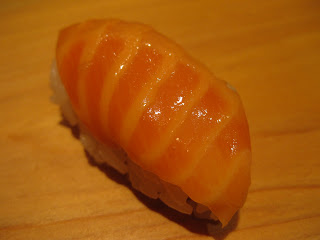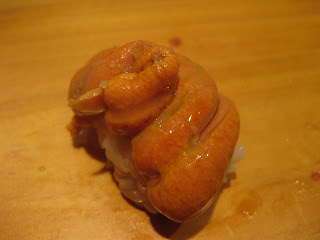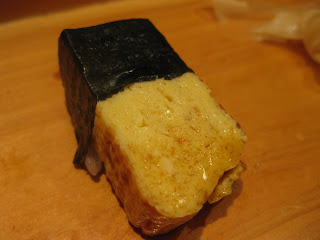Ask anyone where the best sushi in New York is and you'll likely get a plethora of responses. Some may suggest Sushi of Gari, others insist on Kuruma Zushi and the few who've had the luck (and money) to eat there swear by Masa. Instead of arguing over something as subjective as where the best sushi was, I focused my search on where the most traditional sushi was. The fruits of my labor led me to Yasuda and after making a reservation at the sushi bar I wholeheartedly concur; Sushi Yasuda provides a traditional Japanese sushi experience like no other I've experienced in New York.
The interior at Sushi Yasuda was soothing to the eyes; modern and minimalistic, light-colored wood enveloped the restaurant. While there are a few tables the centerpiece of the restaurant is the sushi bar, highlighted by five to six sushi chefs working under spotlights. For full disclosure MW and I were not seated in front of nor was our sushi prepared by Yasuda-san. In fact, upon confirming my reservations I was told by the receptionist that Yasuda-san does not even work on Saturday evenings. Disappointed but not shaken, MW and I were led to inside to the "L-shaped" sushi bar and were immediately given a hot towel for our hands and a pot of Green Tea. MW and I had our minds set on ordering the omakase and leaving the meal in the hands of our capable sushi chef. As much as I like to think I know about sushi I freely admit that I know next to nothing about sake and am usually intimidated by this decision. However, there are only a few selections to choose from at Yasuda and even better they are all $10. MW and I asked our sushi chef for a sake recommendation and he suggested a cold, dry sake from Hokkaido which ended up pairing beautifully with our meal.
For those unfamiliar with Yasuda's omakase there are plenty of discussions on Chowhound but unlike other omakase meals at Yasuda there is no fixed menu or price. Instead, the pieces of fish and corresponding price would vary upon each dining experience. As we told our sushi chef we wanted the omakase he smiled and asked if there was anything we disliked or liked. We informed him that we ate everything but really enjoyed Uni and wanted to try different varieties of the same fish in succession. At Sushi Yasuda the sushi chefs season all the nigiri individually; so word to the wise and put the soy sauce down and don't insult them by asking for additional wasabi. I recall an ex-pat in Japan being escorted out of a sushi restaurant for asking for additional wasabi; and while it may seem a harsh punishment sushi chefs take great pride in their craft and believe too much soy sauce or wasabi masks the true taste of the seafood. We were told that spicy tuna rolls were invented not out of popularity but to cover the poor quality tuna being used. The exception to his rule is with sashimi and rolls which require additional seasoning. Though sushi being served seasoned is a relatively new concept to many Americans it is commonplace in Japan and something I wish more U.S. sushi restaurants would do. Furthermore, everything at Yasuda is homemade; from the soy sauce to the Gari (pickled ginger used to cleanse the pallet) and the use of real wasabi, these details make Yasuda more authentic experience in my opinion.
MW chose to eat her sushi with chopsticks while I chose to eat with my hands. Many Japanese eat sushi without chopsticks and at Yasuda I appreciated that they gave you a towel to wipe your fingers should you choose this option. What surprised me before going into detail of the pieces we ate was that I noticed the rice rather than the fish upon eating my first piece of nigiri. At any other restaurant the fact that the rice and not the fish is the most notable thing would be a bad sign, but not at Yasuda. The rice was so good that I turned to MW and told her, "this is the best sushi rice I've ever eaten," and noticed our sushi chef smile as he overheard my comment. This leads me to my next point, what exactly is sushi? Technically sushi is seasoned rice (usually short to medium grain) with vinegar and sugar that is accompanied with anything from vegetables to seafood. I was also impressed with the size of the nigiri at Sushi Yasuda. Instead of these hulking behemoths of rice at many restaurants Yasuda-san understands that nigiri should be bite-sized. The only time I've come across a piece of sushi with substantially more rice in Japan was when I ate Edo-style sushi which traditionally had a larger rice to seafood ratio. The details at Yasuda that went into something as essential as the rice clearly left an impression on me, and made it an easy comparison to some of the best sushi in Japan.
We started with two pieces of tuna: Maguro (Blue Fin Tuna) and O-toro (Fatty Big Eye Tuna). Both pieces of tuna were good. While the Maguro (Blue Fin Tuna) doesn't have the fat content compared to Chuu-toro or O-toro it tasted very good.
The O-toro (Fatty Big Eye Tuna) was fattier tasted very fresh but I was not sure if I could notice a difference between the two tunas.
Next, we were served Amaebi (Sweet Shrimp), which tasted sweet when combined with the salty soy and fresh wasabi.
Two varieties of Sake (Salmon) were given to us: Wild King Salmon from New Zealand and White King Salmon from Alaska. The Sake (Wild King Salmon) from New Zealand tasted full of flavor compared to some of the farm-raised salmon served at other sushi restaurants.
The Sake (White King Salmon) from Alaska was a treat for both MW and I, as neither had ever tried it before. Compared to the Sake from New Zealand the Sake from Alaska was fattier and tasted sweeter; easily one of the highlights of the meal.
We were then given a piece of Masu (Ocean Trout) from Tasmania. I have previously had Masu sashimi at Soto where I originally mistook it for Salmon as the color is a similar bright orange.
Next was Hotate (Scallop), Himejako (Giant Clam Fringe) and a Peace Passage Oyster from Washington. All three pieces of nigiri were seasoned with lemon and salt that highlighted the sweetness of each shellfish. The Hotate (Scallop) was one of the sweetest scallops I've ever eaten, another favorite from the meal.
The Himejako (Giant Clam Fringe) was a favorite of MW, having an enjoyable texture that is slightly chewy and sweet.
The Peace Passage Oyster was completely new us. But the novelty of oyster nigiri quickly turned to love as the briny-sweetness of the oyster mixed with the rice and finished with a taste of the ocean as all good oysters do.
Next was the Eel course as we were given Unagi Kuro (Fresh Dark Freshwater Eel) and Anago (Fresh Dark Sea Eel). Yasuda-san had previously worked in a eel restaurant and is considered a specialty of the restaurant as it boasts five different pieces. You are lucky to find two different pieces of eel at any other sushi restaurant and we were eager to try them all. Eaten back-to-back, the Unagi Kuro had a much meatier consistency than the Anago, yet the Anago was sweeter and more delicate than the Unagi. MW preferred the Anago to the Unagi; but in my opinion both were great.
Next, a trio of: Shimaaji (Yellowtail), Hirame (Fluke) and Orato (Sea Bream). The Shimaaji (Yellowtail) tasted fresh and clean; good but nothing extraordinarily good.
The Hirame (Fluke) was very good. Subtle and sweet the fresh wasabi seemed more prominent here, not sure if this was intentional or not.
The Orato (Sea Bream) reminded me of the Hirame. A subtle sweetness that spoke to the the freshness of the fish.
Then came two more fishes: Nijimasu (Rainbow Trout) and Aji (Spanish Mackerel). I thought that the Nijimasu (Rainbow Trout) was very good and was my first sushi experience with the fish; it tasted sweet and fresh.
The Aji (Spanish Mackerel) isn't among the my favorite fishes as it tends to have an oily flavor that often overpowering. I'm happy to say that this was not the case with this piece.
We were given more shellfish: Aoyagi (Orange Clam), Sumi Ika (Squid) and Kani (Rock Crab). Aoyagi (Orange Clam) nigiri has never been my favorite piece of sushi but this was a better version that I've had previously.
The Sumi Ika (Squid) was very good. Compared to other pieces of Ika (Squid) this was more tender; a trait that both MW and I appreciated.
The Kani (Rock Crab) was delicious. Sweet hand-picked rock crab, brightened with spritz of lemon and a slight crunch of sea salt was another of the more memorable sushi of the evening.
More tuna followed the shellfish. We were given both Chuu-toro (Semi-Fatty Blue Fin Tuna) and O-toro (Fatty Blue Fin Tuna). The Chuu-toro was rich but the O-toro was sublime. I joked with our sushi chef that all American's were enamored with Toro (Fatty Tuna) but even my snarkiness couldn't deny the quality of this fish. The fat was so abundant that it resembled a well-marbled Kobe steak.
Finally, the best for last...Uni! Our sushi chef gave us two pieces: Uni (Sea Urchin) from Maine and Uni (Sea Urchin) from Alaska. The Uni from Alaska was sweeter and didn't have quite as intense flavor we are used to than the variety from Maine. I was surprised because we were told that the Alaskan Uni was similar to the Santa Barbara variety while the Maine variety is more similar those found in Japan. In short, both were good and if you are a fan of Uni you owe it to yourself to go and try both next to each other.
We were given three pieces of a Toro Scallion Roll (Fatty Tuna Scallion) and were instructed to use the house-made soy sauce. While the roll seemed pretty ordinary flavor wise, MW couldn't get over the quality of the nori (seaweed) and loved it.
At this point our sushi chef asked us if we wanted to keep going or wanted to stop. Glancing at the menu I noticed that there were a couple of pieces we had not tried and told him to continue on. The first piece we were given was Kuchiko (Female Scallop Roe), our sushi chef suggested this piece because of its similar taste to Uni. The flavor was sweet but had a subtle taste similar to Uni.
Seeing how we loved the previous pieces of eel, we were then served two different pieces of eel: Sawani (Fresh White Sea Eel) and Shirayaki (Fresh White Freshwater Eel). As before, the Shirayaki was meatier than Sawani but the Sawani was sweeter than the Shirayaki. I did like the slight-smoke flavor of the Shirayaki that was grilled.
Lastly, given the choice of dessert (Mochi Ice Cream) or more sushi we comprised and split two more pieces of sushi traditionally served to close a meal: Tomago (Egg Omelet) and Egg Custard (made with Dashi and Shrimp).
Though I was initially worried that we might push the two hour time limit at the sushi bar, we finished right in time. Blessed with a knowledgeable and friendly sushi chef, professional staff and wonderful food, all the little but noticeable details accumulated to make Sushi Yasuda a more traditional sushi experience than other sushi restaurants in New York. If good meals transport you to a different place then Sushi Yasuda brought me back to the sushi shacks at Tsukiji and the high end restaurants in Ginza and Roppongi minus the $1,200 plane ticket and 14-hour flight.
Sushi Yasuda
204 East 43rd Street
New York, NY 10017
(212) 972-1001
http://www.sushiyasuda.com/
To see all our pics, please click the flickr link.


































Absolutely agree. Yasuda is real sushi. A place like Sushi of Gari is great food, but they do not create traditional sushi. They have "creative" sushi. Actually, I do not believe you can really compare the two as the food is quite different. Yasuda is the best sushi I have had in the US or Japan. I have been living in Japan for over a year now.
ReplyDelete